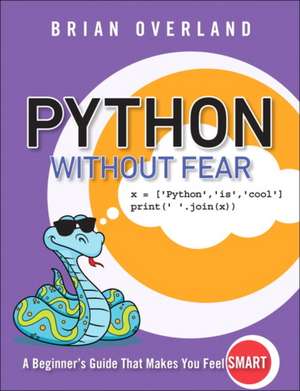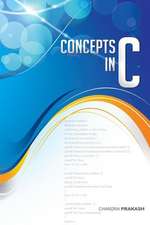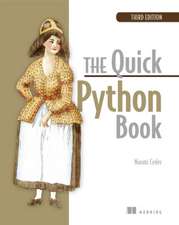Python Without Fear
Autor Brian Overlanden Limba Engleză Paperback – 31 dec 2017
- Covers installing and using the newest Python 3.x versions, and shows how to adapt your code for older versions
- Teaches with puzzles, games, and relevant exercises
- Offers more "why" and "how-to" coverage--reveals how Python works "under the covers," so you can avoid time-consuming mistakes
- Takes you from basic scripting to advanced objects and data management
- Contains an expanded reference section for all your day-to-day programming
- Well-designed for programmers who've previously used C, C++, Visual Basic, or Java
Preț: 209.82 lei
Preț vechi: 262.28 lei
-20% Nou
40.15€ • 41.92$ • 33.23£
Carte disponibilă
Livrare economică 15-29 martie
Livrare express 01-07 martie pentru 37.10 lei
Specificații
ISBN-10: 0134687477
Pagini: 528
Dimensiuni: 179 x 231 x 25 mm
Greutate: 0.73 kg
Editura: PEARSON PROFESSIONAL COMPUTING
Notă biografică
Brian Overland is a textbook author, sometime actor, programmer, film reviewer, and novelist. He has been professionally programming with the C family of languages since the early 1980s and spent 10 years at Microsoft, first as a software tester and then as programmer/writer, manager, and project lead. Almost unique among programmers, he is an award-winning writer deeply committed to teaching and simplifying advanced concepts.
Cuprins
Preface xvii
Acknowledgments xxi
Author Bio xxiii
Chapter 1: Meet the Python 1
A Brief History of Python 1
How Python Is Different 2
How This Book Works 3
Installing Python 4
Begin Using Python with IDLE 6
Correcting Mistakes from Within IDLE 6
Dealing with Ends of Lines 7
Additional Help: Online Sources 8
Chapter 2: A Python Safari: Numbers 9
Python and Numbers 9
Python and Floating-Point Numbers 14
Assigning Numbers to Variables 17
Variable-Naming Conventions in This Book 23
Some Python Shortcuts 23
Chapter 2 Summary 26
Chapter 3: Your First Programs 29
Temperatures Rising? 29
Putting in a Print Message 35
Syntax Summaries 36
Getting String Input 41
Getting Numeric Input 43
Formatted Output String 46
Chapter 3 Summary 50
Chapter 4: Decisions and Looping 53
Decisions Inside a Computer Program 53
Conditional and Boolean Operators 55
The if, elif, and else Keywords 56
while: Looping the Loop 60
"Give Me a break" Statement 70
Chapter 4 Summary 75
Chapter 5: Python Lists 77
The Python Way: The World Is Made of Collections 77
Processing Lists with for 80
Modifying Elements with for (You Can't!) 82
Indexing and Slicing 85
Copying Data to Slices 88
Ranges 89
List Functions and the in Keyword 97
Chapter 5 Summary 99
Chapter 6: List Comprehension and Enumeration 101
Indexes and the enumerate Function 101
The Format String Method Revisited 103
Simple List Comprehension 106
"Two-Dimensional" List Comprehension 112
List Comprehension with Conditional 114
Chapter 6 Summary 123
Chapter 7: Python Strings 125
Creating a String with Quote Marks 125
Indexing and "Slicing" 127
String/Number Conversions 130
Stripping for Fun and Profit 135
Let's Split: The split Method 138
Building Strings with Concatenation (+) 139
The join Method 143
Chapter 7 Summary 144
Chapter 8: Single-Character Ops 147
Naming Conventions in This Chapter 147
Accessing Individual Characters (A Review) 148
Getting Help with String Methods 148
Testing Uppercase vs. Lowercase 149
Converting Case of Letters 150
Testing for Palindromes 151
Converting to ASCII Code 159
Converting ASCII to Character 160
Chapter 8 Summary 166
Chapter 9: Advanced Function Techniques 167
Multiple Arguments 167
Returning More Than One Value 168
Arguments by Name 173
Default Arguments 174
Importing Functions from Modules 178
Chapter 9 Summary 185
Chapter 10: Local and Global Variables 187
Local Variables, What Are They Good For? 187
Locals vs. Globals 188
Introducing the global Keyword 190
The Python "Local Variable Trap" 190
Chapter 10 Summary 204
Chapter 11: File Ops 207
Text Files vs. Binary Files 207
The Op System (os) Module 208
Open a File 211
Let's Write a Text File 213
Read a Text File 216
Files and Exception Handling 217
Other File Modes 223
Chapter 11 Summary 224
Chapter 12: Dictionaries and Sets 227
Why Do We Need Dictionaries, Ms. Librarian? 227
Adding and Changing Key-Value Pairs 229
Accessing Values 230
Searching for Keys 231
Converting Dictionaries to Lists 235
All About Sets 241
Operations on Sets 242
Chapter 12 Summary 246
Chapter 13: Matrixes: 2-D Lists 249
Simple Matrixes 249
Accessing Elements 250
Irregular Matrixes and Length of a Row 251
Multiplication (*) and Lists 252
The Python Matrix Problem 253
How to Create N*M Matrixes: The Solution 254
How to Rotate a Matrix 261
Chapter 13 Summary 268
Chapter 14: Winning at Tic-Tac-Toe 271
Design of a Tic-Tac-Toe Board 271
Plan of This Chapter 273
Python One-Line if/else 274
The count Method for Lists 279
Introducing the Computer Player 285
Chapter 14 Summary 294
Chapter 15: Classes and Objects I 295
What's an Object? 295
Classes in Python 296
The All-Important _ _init_ Method 301
Design for a Database Class 303
Defining Other Methods 309
Design for a Point3D Class 310
Point3D Class and Default Arguments 312
Three-Dimensional Tic-Tac-Toe 312
Chapter 15 Summary 318
Chapter 16: Classes and Objects II 321
Getting Help from Doc Strings 321
Function Typing and "Overloading" 323
Variable-Length Argument Lists 326
Inheritance 331
The Fraction Class 333
Class Variables and Methods 337
Instance Variables as "Default" Values 339
Chapter 16 Summary 344
Chapter 17: Conway's Game of Life 347
Game of Life: The Rules of the Game 348
Generating the Neighbor Count 350
Design of the Program 352
Moving the Matrix Class to a Module 354
The Famous Slider Pattern 358
Chapter 17 Summary 364
Chapter 18: Advanced Pythonic Techniques 367
Generators 367
Exploiting the Power of Generators 369
Properties 375
Decorators: Functions Enclosing Other Functions 382
Python Decoration 385
Chapter 18 Summary 389
Appendix A: Python Operator Precedence Table 391
Appendix B: Summary of Most Important Formatting Rules for Python 3.0 393
1. Formatting Ordinary Text 393
2. Formatting Arguments 393
3. Specifying Order of Arguments 393
4. Right Justification Within Field of Size N 394
5. Left Justification Within Field of Size N 394
6. Truncation: Limit Size of Print Field 394
7. Combined Truncation and Justification 395
8. Length and Precision of Floating-Point Numbers 395
9. The Padding Character 395
Appendix C: Glossary 397
Index 407















